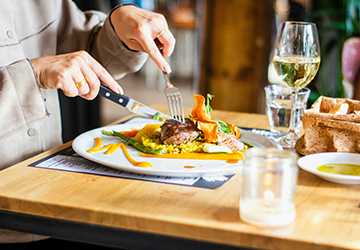Pairing wine and food for a feast can be challenging. Since there are so many different wine pairings with other dishes, the question arises: what suits your moat tastes? The basis is familiarity with the basic flavour categories. When you combine and pair wine and food correctly, you get the most out of them. This mentality results in wine and meal pairings that highlight their tastes.

Check out the standout flavours
Look at your dish and note the main flavour components. Is it creamy, salty, sweet or sour? Rich or light? For red meat, you want a rich red wine to bring out the rich flavour of the meat. For example, consider pairing Mendoza or Malbec with steak. When it comes to rich, creamy pasta, a refreshing white wine like Chardonnay or Sauvignon Blanc can provide a smooth, creamy flavour. Vary the volume and note the intensity. Lighter wines are best paired with those too intense to handle such a small fish.
Consider cooking methods
The way the dishes are prepared is also related to the wine pairings. Grilled food with darkened edges pairs well with spicy-toned wines, such as Syrah or Pinot Noir. The whole fish is cooked in a way that does not overwhelm the taste buds and requires a delicate wine, preferably a dry white like Pinot Grigio. Sparkling wine should be used with fried foods because they contain air bubbles that eliminate crispy skin.
Imagine spices and herbs in the kitchen
Spices present different flavours, and wine can enhance these flavours. Grilled chicken breast has a familiar fennel flavour paired with Gewürztraminer's essential spice. Sauternes pair perfectly with desserts, while sweet dishes balance the acidity of Sauvignon Blanc and complement the spicy citrus notes. Dishes containing truffles, mushrooms or thyme pair well with earthy Pinot Noir wines. If the sauce has a cream base, your best wine choice might be a buttery chardonnay. Detail the flavouring elements in your dish and choose wine flavours that complement your meal.
Be careful with salt
Salt can make wine taste flat or bland. To avoid this, savoury dishes should be paired with wines with a slightly higher pH. The pH level a wine maintains determines its brightness. For fine ham, prosciutto, or aged cheese, try a light sparkling wine. The acidity helps cut through the fat, allowing you to serve your sparkling wine as a perfect appetizer.
Regional thinking
Classic wine and food combinations appear somewhere because they go together, like a region's local food and wine. Sangiovese wine from Tuscany combines tomatoes and herbs perfectly in Bolognese cuisine. Spanish Rioja red wine is known for its rich flavour in paella flavoured with saffron and paprika. You'll find German Riesling associated with sauerkraut and sausage. We feature eight wines, each of which makes German Riesling unique. If you need help figuring out where to maintain flavour variety, look to tried-and-true combinations of local favourites.
Adjust weight
Combine light foods with light wines and heavy foods with rich wines. Foodies can spice it up with a refreshing white wine like Pinot Gris to balance the flavours. A tannic, full-bodied Cabernet Sauvignon will outshine the fish. However, a contract steak requires a full-bodied red wine, which has to be hearty. Structured wines like Cabernet Sauvignon have the texture needed for dense pulp.

Bridge aroma
Looking for these flavour bridges and trying to find two or even three helps absorb them and experience their unity and coherence. When dishes and wines contain similarly different flavors of fruit, herbs, or spices, they are natural companions. The dish paired with blackberry merlot showcases the delicious harmony of blackberry-glazed pork chops. Rosemary works in chunks both in the lamb chops and in the Sangiovese and ties the two together successfully. Wine should subtly introduce taste sequences common to food.
Consider comparing flavours
It's not just the flavour that works; the other combinations work too. Contrasting flavours enhance this balance. Acidic, low-alcohol wine can soften the sweetness of chocolate desserts. When it comes to Riesling, the most crucial thing is acidity. It goes well with buttery, creamy dishes. The creamy foam and carb dough combine perfectly. The repulsive force between the poles of a magnet reminds me to always look for contrast. Satisfy your taste buds by pairing different wines with food.
Think differently
Once you get the hang of it, it's time to try new combinations. Experiment with different herbs, spices and garnishes to blend flavours, textures and temperatures. Thai food is famous for its spiciness. For a sweeter taste, temper the fire with a sweet Riesling. Wine selections for the cheese plate include oaked Chardonnay with buttery Brie, sweet wine with blue cheese, and tannic Cabernet Sauvignon with aged Gouda. Be brave and try different things.
Diploma
Master basic pairing skills; you can confidently pair wine with everything from weeknight dinners to survival feasts. Try different foods, identify wine and food flavours, and note the similarities you remember, such as strength, weight, and regional characteristics. The point here is to enjoy different wines until you find a combination that reminds you of "Yummy!" What wine would you pair with the meal at your next celebration?